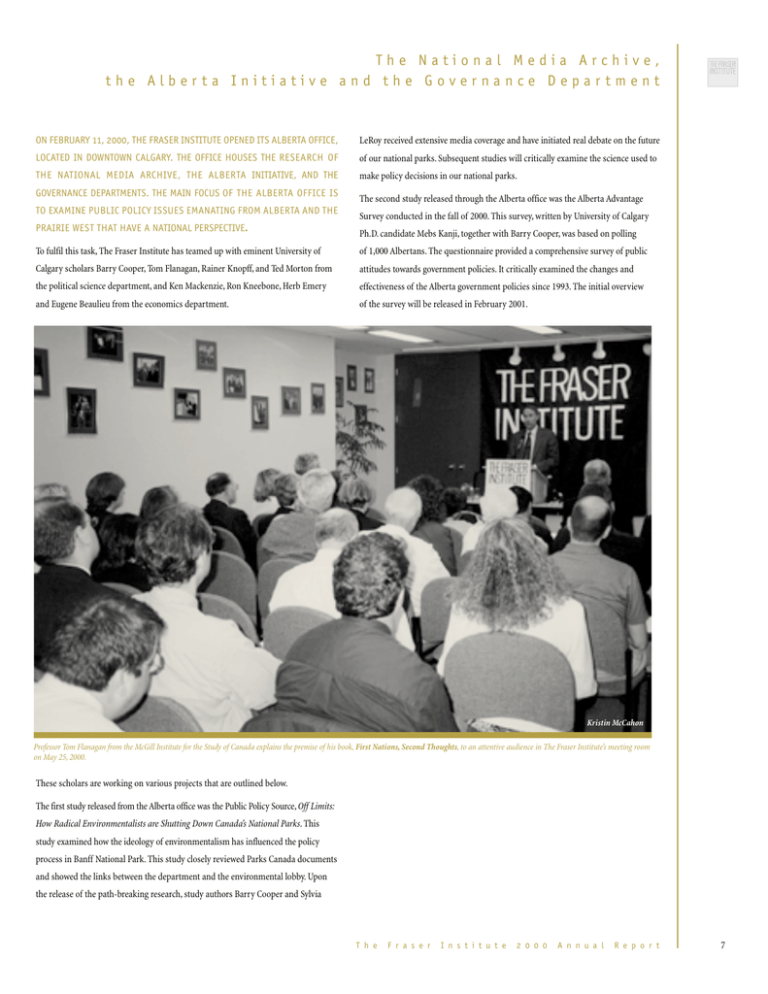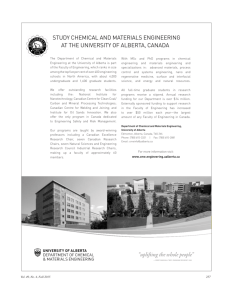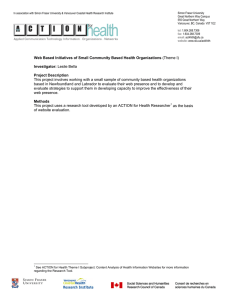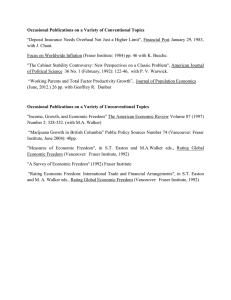T h e N a t i o... t h e A l b e r...
advertisement

The National Media Archive, the Alberta Initiative and the Governance Department ON FEBRUARY 11, 2000, THE FRASER INSTITUTE OPENED ITS ALBERTA OFFICE, LeRoy received extensive media coverage and have initiated real debate on the future LOCATED IN DOWNTOWN CALGARY. THE OFFICE HOUSES THE RESEARCH OF of our national parks. Subsequent studies will critically examine the science used to THE NATIONAL MEDIA ARCHIVE, THE ALBERTA INITIATIVE, AND THE make policy decisions in our national parks. GOVERNANCE DEPARTMENTS. THE MAIN FOCUS OF THE ALBERTA OFFICE IS TO EXAMINE PUBLIC POLICY ISSUES EMANATING FROM ALBERTA AND THE PRAIRIE WEST THAT HAVE A NATIONAL PERSPECTIVE. The second study released through the Alberta office was the Alberta Advantage Survey conducted in the fall of 2000. This survey, written by University of Calgary Ph.D. candidate Mebs Kanji, together with Barry Cooper, was based on polling To fulfil this task, The Fraser Institute has teamed up with eminent University of of 1,000 Albertans. The questionnaire provided a comprehensive survey of public Calgary scholars Barry Cooper, Tom Flanagan, Rainer Knopff, and Ted Morton from attitudes towards government policies. It critically examined the changes and the political science department, and Ken Mackenzie, Ron Kneebone, Herb Emery effectiveness of the Alberta government policies since 1993. The initial overview and Eugene Beaulieu from the economics department. of the survey will be released in February 2001. Kristin McCahon Professor Tom Flanagan from the McGill Institute for the Study of Canada explains the premise of his book, First Nations, Second Thoughts, to an attentive audience in The Fraser Institute’s meeting room on May 25, 2000. These scholars are working on various projects that are outlined below. The first study released from the Alberta office was the Public Policy Source, Off Limits: How Radical Environmentalists are Shutting Down Canada’s National Parks. This study examined how the ideology of environmentalism has influenced the policy process in Banff National Park. This study closely reviewed Parks Canada documents and showed the links between the department and the environmental lobby. Upon the release of the path-breaking research, study authors Barry Cooper and Sylvia T h e F r a s e r I n s t i t u t e 2 0 0 0 A n n u a l R e p o r t 7 The National Media Archive, the Alberta Initiative and the Governance Department Magelle’s Photography Professor Tom Flanagan answers questions on his book, First Nations, Second Thoughts at an Executive Advisory Luncheon at The Fraser Institute’s head office on May 25, 2000. Kristin McCahon Fraser Institute staff in the Calgary office. Back row, from left: Dr. Ken McKenzie, Senior Fellow; Dr. Eugene Beaulieu, Senior Fellow; Ms. Connie Embreus, Research Assistant; Executive Director Dr. Michael Walker, Dr. Rainer Knopff, Senior Fellow; Dr. Barry Cooper, Senior Fellow. Front row (left to right): Ms. Sylvia LeRoy, Policy Analyst; Mr. Mischa Kowell, Research Assistant; Mr. Mebs Kanji, Research Associate; Ms. Pauline Hughes, Fundraising Associate. Missing: Dr. Lydia Miljan, Director of the Alberta Initiative. Other studies slated for research and release in 2001 include: ❚ The Cost of Judicial Decisions (under the guidance of constitutional scholars Rainer Knopff and Ted Morton). This study will provide an economic analysis of the cost of judge-made laws. The first part of this study will examine the direct costs incurred by governments when the courts rule that they must pay damages or costs. Subsequent analysis will examine the potential costs of judicial decisions. ❚ Public Land Use in Alberta is an analysis of changes in legislation that will affect the management of leased grazing land in Alberta. The project will also examine the role of regulations in the green space within the province. ❚ The rules involved in conducting research and development (headed by Ken Mackenzie) is a project that will examine the differences between Canada and other countries with respect to the rules and definitions of R&D. ❚ Obsolete Monopoly is an analysis of the operations of the Canadian Wheat Board and a recommendation of market alternatives. This study examines material in the National Archives dealing with the Canadian Wheat Board over the last 60 years. The goal is to provide a narrative history of this government body, to evaluate its performance, and to indicate the attractiveness of the “dual marketing” alternative. ❚ Preliminary research is being conducted on the feasibility of a study to examine the connection between property, civil society, and markets on aboriginal reserves. With the National Media Archive, Lydia Miljan continues to examine contentious issues and their coverage in the national media. During 2001 we will be publishing the results of a study that examines the relationship between journalists’ personal opinions and news coverage. 8 Fiscal Studies ONE OF THE MOST WIDELY-RECOGNIZED REPORTS FROM ANY PUBLIC POLICY INSTITUTE IN CANADA IS “TAX FREEDOM DAY”—THE DAY IN THE YEAR WHEN THE AVERAGE FAMILY HAS EARNED ENOUGH MONEY TO PAY THE TOTAL TAX BILL LEVIED ON IT BY ALL LEVELS OF GOVERNMENT. THIS CALCULATION, WHICH THE FRASER INSTITUTE HAS BEEN MAKING FOR 23 YEARS, IS AN IMPORTANT FIXTURE IN THE DEBATE REGARDING GOVERNMENT SPENDING AND TAXATION IN CANADA. THE FISCAL STUDIES DEPARTMENT CALCULATES TAX FREEDOM DAY FOR CANADA AND THE PROVINCES EACH YEAR; IN 1999 IT BEGAN OFFERING AN AUTOMATED, WEB-BASED CALCULATOR SO THAT ANYONE INTERESTED COULD Adele Waters DETERMINE THEIR OWN PERSONAL TAX FREEDOM DAY. During 2000, The Fraser Institute hosted the second in a series of symposia on capital gains taxation. It was attended by experts from around the world, including Australia, New Zealand, Ireland, the Netherlands, the United Kingdom, Mexico, and the United States. In addition, Senior Fellow and holder of the David Somerville Chair in Fiscal Studies, Dr. Herbert Grubel, published the first volume in a series on capital gains taxation based on papers submitted to the previous year’s symposium. Both the symposia and book have had a significant impact on the country’s capital gains tax regime; the inclusion rate for capital gains tax has been reduced from 75 percent to Mr. Donald Tsang, Financial Secretary, Hong Kong Special Administrative Region, briefs Institute staff and members about “The Free Market Economy: Maintaining the Momentum” on June 8, 2000, in Vancouver. Four surveys of senior investment managers were produced in 2000. They paid critical attention to both the provincial investment climates and the federal budget. The surveys are based on the responses of senior investment officers who collectively manage over $190 billion worth of assets. The surveys received the support of the Investment Dealers Association (IDA) which became a partial sponsor of the project in 2000. 50 percent since the series of symposia began. The Fiscal Studies department completed background and response papers for Major revisions to the Budget Performance Index were completed in 2000 under the stewardship of Senior Research Economist Joel Emes. The changes vastly improved the quality and usefulness of this budget summary document, the findings of which were highlighted in a number of prominent newspapers and radio shows. In addition to the Budget Performance Index, another occasional paper was completed in 2000 by former intern and current doctoral candidate, Marc Law. Entitled Productivity and Economic Performance, the paper summarizes issues relating to productivity and provides performance data for Canada relative to our competitors. both the federal and British Columbia budgets in addition to commenting on other provincial budgets including those of Alberta, Ontario, and Saskatchewan. The responses were prominently featured in such newspapers as the National Post and the Vancouver Sun. Throughout the year, the department completed articles on a wide range of fiscal issues including government support for innovation, corporate subsidies, international efforts to harmonize taxes, budget summaries, and the federal government’s year-end spending spree. In addition to the articles appearing in Fraser Forum, the department also completed a series of question-and-answer pieces that provide empirical information on a range of subjects including government spending priorities, the public sector, agricultural support, per capita incomes and government spending, and the changing tax mix. A number of these pieces were covered by major papers including the National Post, the Globe and Mail, the Vancouver Sun, the Calgary Herald, and the Ottawa Citizen. A number of important initiatives were begun in 2000 that will be completed in 2001. For instance, two major research studies, Returning British Columbia to Prosperity and Flat Tax: Issues and Principles were both started in 2000 and will be released in early 2001. Also, major revisions and improvements were also begun to our study of Adele Waters Canada’s debt, particularly the manner in which unfunded liabilities are calculated. In the coming year, the Fiscal Studies department will continue to take a broad Participants in the 2000 Symposium on Capital Gains Taxation held in Vancouver on September 15-17, 2000 were: Dr. Barry Bracewell-Milnes, Mr. Jason Clemens, Professor Sijbren Cnossen, Mr. John Dobson, Professor Steve Easton, Professor John Freebairn, Mr. Francisco Gil Diaz, Dr. Herbert G. Grubel, Professor Jonathan Kesselman, Mr. Peter Kugler, Professor Moore McDowell, Mr. Fred McMahon, Mr. Robin Oliver, Dr. Alan Reynolds, Mr. Munir A. Sheikh, Mr. David Somerville, Professor Zane Spindler, Dr. Ruul P. van den Dool, Dr. Michael A. Walker, Professor Thomas Wilson, Professor Chi-Wa Yuen. view of fiscal issues, including not only the amount government spends and taxes, but also how government spends and taxes. The department will continue to examine international, national, and sub-national issues, particularly the benefits of economic growth. T h e F r a s e r I n s t i t u t e 2 0 0 0 A n n u a l R e p o r t 9 Non-Profit Studies LAST YEAR MARKED THE THIRD FULL YEAR OF STUDIES DEDICATED TO THE NON- Awards, but for the whole department.As governments of all stripes look for new and PROFIT SECTOR. A NUMBER OF IMPORTANT UNDERTAKINGS WERE COMPLETED innovative ways to provide social services, the non-profit sector’s visibility and DURING THE YEAR, INCLUDING THE THIRD ANNUAL DONNER CANADIAN importance will continue to increase. The Non-Profit Studies department will continue FOUNDATION AWARDS AND THE THIRD INSTALMENT OF THE GENEROSITY INDEX. to update past studies and provide additional new information on this unique and In 2000, the Donner Canadian Foundation Awards were hosted and presented by the vital component of society. Lieutenant Governor of Ontario, the Honourable Hilary M. Weston, at a ceremony held at Queen’s Park. Nine agencies were awarded a total of $65,000 and were formally recognized for their high performance standards in providing social services. Finalists and recipients of these national awards came from across Canada, including British Columbia, Alberta, Saskatchewan, Manitoba, Ontario, Nova Scotia, and Newfoundland. The Donner Canadian Foundation Awards were pleased to co-host the event with the Drucker Canadian Foundation. In 2000, the third instalment of the Generosity Index, which measures the extent of financial generosity across Canadian provinces and US states, was completed. The study continues to receive prominent newspaper, radio, and television coverage. In the coming year, the Non-Profit Studies Department will endeavour to improve the measurement, and will seek a US Institute to co-publish the results for even greater media exposure. Stephanie Lake A number of initiatives are planned for 2001, including expansion of the Donner Canadian Foundation Awards and more research into the non-profit sector. The addition of Karina Wood in October 2000 as the co-ordinator for the Donner Canadian Foundation Awards provides great promise not only for the Donner The joint winners of the 2000 Donner Canadian Foundation Award for Excellence in the Delivery of Social Services. Left, Mary-Ellen Blizzard representing Sarnia-Lambton Rebound (Crisis Intervention category winner) and right, Mark Wolff representing the Multiple Sclerosis Society of Canada, Calgary Chapter (Services to the Disabled category winner), with the Honourable Hilary M. Weston, Lieutenant Governor of Ontario. Charles Kochman The third annual Donner Canadian Foundation Awards for Excellence in the Delivery of Social Services were presented at a ceremony hosted by the Lieutenant Governor of Ontario, the Honourable Hilary M. Weston, on Oct. 13, 2000. From left to right, top: Ruthann Tucker (FIFE House), Mary-Ellen Blizzard (Sarnia-Lambton Rebound), Mark Wolff (Multiple Sclerosis Society of Canada, Calgary Chapter), Paul O’Krafka (St. Joseph’s Villa), Brenda Thorlakson (Vernon & District Hospice Society), Eunice Cameron (Cornwall Alternative School). From left to right, bottom: Grace Wood (Julien House Society), Lynn Huizer (York Region Abuse Program), R.J. Addington, O.B.E. (Chairman, The Fraser Institute), the Honourable Hilary Weston, Allan Gotlieb (Donner Canadian Foundation), Diane Doneff (Women’s Addiction Recovery Mediation), and Scott Dunlop (Kitsilano Area Childcare Society). 10 Risk, Regulation & the Environment IN 2000, THE FRASER INSTITUTE EXPANDED THE FOCUS OF THE ENVIRONMENTAL STUDIES DEPARTMENT AND LAUNCHED THE CENTRE FOR STUDIES IN RISK AND REGULATION. THE CENTRE AIMS TO EDUCATE CANADIAN CITIZENS AND POLICY MAKERS ABOUT THE SCIENCE AND ECONOMICS OF RISK CONTROVERSIES. As incomes and living standards have increased, tolerance for the risks associated with everyday activities has decreased. While this decreased tolerance for risk is not in and of itself undesirable, it has made us susceptible to unsound science. Concern over smaller and smaller risks in society, both real and imagined, has led people to demand more regulation without taking into account the costs—including foregone opportunities to reduce more threatening risks. If the costs of policies intended to reduce risks are not accounted for, there is a danger that well-intentioned policies will actually reduce public well-being. To promote more rational decision making, the Centre for Studies in Risk and Regulation will focus on sound science and consider Lorena Baran the costs as well as the benefits of policies intended to protect Canadians. Fraser Institute Director of the Centre for Risk and Regulatory Studies, Ms. Laura Jones, speaks on “The Environment and Economic Freedom” to the Western Economic Association Conference in June. The Centre was launched at a lunch held in Toronto on November 21, where ABC News Correspondent John Stossel spoke about what the real risks in life are, why the media ceaselessly hype unrealistic fears, and why readers and viewers are swayed by it. The lunch was well attended by journalists, industry representatives, and students. The Centre also released its first publication, the book Safe Enough? Managing Risk and Regulation. Environmental studies continue under the new umbrella of risk and regulation. The fourth edition of the Critical Issues Bulletin Environmental Indicators was published in April to help focus Earth Day (April 22) debates on trends in environmental quality. The study examines trends in the areas of air quality, water quality, natural Charles Kochman resource use, land use, and solid waste disposal. Contrary to popular public opinion, the indicators study shows that in many of these areas, environmental quality has Ms. Laura Jones, Director of the Centre for Studies in Risk and Regulation, and ABC 20/20 Correspondent Mr. John Stossel at the Risk and Regulation centre’s inaugural luncheon, where Mr. Stossel spoke on “Pandering to Fear: The Media’s Crisis Mentality.” improved significantly over the past 20 years. The fourth edition contained information on the United Kingdom, Mexico, and South Korea. The problems facing the mining industry were once again highlighted in The Fraser Institute Annual Survey of Mining Companies. The survey asks companies to reveal how policy factors such as taxation, regulation, and uncertainty concerning land use affect their investment decisions. In addition to publishing new studies, the Centre is working on getting broader distribution of its ideas. To this end, money was raised to send complimentary copies of the book Facts, Not Fear to every school library in Ontario. The book reviews what children in primary and secondary school learn about the environment from their textbooks, teachers, and outside reading. It counters some of the irresponsible claims of environmental extremists and provides a more balanced view of popular Charles Kochman environmental controversies. ABC News Correspondent Mr. John Stossel (far left) at a reception prior to his luncheon address. National Post editor Mr. Terry Corcoran (far right) introduced Mr. Stossel at the luncheon. T h e F r a s e r I n s t i t u t e 2 0 0 0 A n n u a l R e p o r t 11 Canada Project Social Affairs THE CANADA PROJECT FOCUSES ON OUR INSTITUTIONS OF GOVERNANCE, MANY OF TODAY’S MOST PRESSING PUBLIC POLICY CONCERNS REVOLVE FEDERALISM, AND ABORIGINAL POLICY. IN EACH OF THESE AREAS, CONCEPTS AROUND SOCIAL POLICY. SADLY, SOCIAL PROGRAMS TOO OFTEN PERPETUATE SUCH AS THE RULE OF L AW, ACCOUNTABILIT Y, TRANSPARENCY, AND THE PROBLEMS THEY ARE MEANT TO SOLVE. INSTEAD OF STRESSING INDIVIDUAL SUBSIDIARITY (THE APPROPRIATE DEGREE OF DECENTRALIZATION) INFORM RESPONSIBILIT Y AND CHOICE, THEY ARE MEANT TO RELIEVE THE THE RESEARCH AND COMMUNICATIONS OF SENIOR FELLOW GORDON GIBSON. CONSEQUENCES OF BAD CHOICES. THE SOCIAL AFFAIRS CENTRE EXAMINES Highlights of the year included the publication of the Public Policy Source, Principles EMPIRICAL EVIDENCE AND THEORETICAL WORK FROM AROUND THE WORLD TO for Treaty Making, and a major paper presented by invitation to the Queen’s Institute SEEK POLICIES THAT EMPOWER INDIVIDUALS TO ESCAPE FROM THE POVERTY of Intergovernmental Affairs on British Columbia on the federation and the need for TRAP. AS WELL, THE CENTRE EXAMINES A RANGE OF OTHER SOCIAL ISSUES decentralization. Numerous articles on these topics also appeared in Fraser Forum. FROM DRUG POLICY TO CRIME TO EDUCATION. Invited testimony was provided to the Senate Committee on the Nisga’a Treaty and to During 2000, the Social Affairs Centre saw one of its most successful initiatives the House Committee on the Clarity Act. National unity is by no means yet secured, become its own centre. The innovative work by Peter Cowley and Senior Fellow and remains a preoccupation of the project. Stephen Easton on school measurement has sharpened the debate on the quality of our public education. Peter now heads the Department of School Performance Studies and has produced a series of report cards on schools across the nation. Social Affairs continues to examine educational issues related to higher education. The Centre continues its work in developing a successful metric for social questions. The Centre has commissioned a new edition of Chris Sarlo’s groundbreaking study, Poverty in Canada. This is the best measurement ever produced of the real extent of poverty in this nation. The new edition will be published in 2001. Annabel Addington Fraser Institute Senior Fellow in Canadian Studies Mr. Gordon Gibson (right) listens to one of the founders of the intellectual movement known as public choice, Dr. Gordon Tullock, Professor of Economics and Law at George Mason University in Virginia. The two were attending a Fraser Institute-hosted dinner following the Western Economic Association Conference, held on June 30, 2000 in Vancouver. A growing focus of this project is the increasingly dysfunctional performance of our parliamentary system. In this connection, Mr. Gibson participated in the work of the Ad Hoc Committee for a Provincial Constitution which reported early this year on a model process (a constituent assembly) and direction for democratic reform in British Columbia. Numerous appearances throughout the year in the press and on television, radio, and public appearances complemented the above. In addition, Mr. Gibson maintains research relationships with government and academic workers in these fields both federally and provincially in Canada, and in the United States and Australia. Lorena Baran Brother Bob Smith, Messmer High School, Milwaukee, Wisconsin, at the conference School Choice: Dispelling the Myths and Examining the Evidence, April 1, 2000. 12 School Performance Studies IN 2000, SCHOOL PERFORMANCE STUDIES, NOW A SEPARATE DEPARTMENT OF THE FRASER INSTITUTE, MADE RAPID PROGRESS TOWARD ITS OBJECTIVE OF RATING AND RANKING ALL OF CANADA’S SCHOOLS. In March, the department released the third edition of the Report Card on British Columbia’s Secondary Schools. It introduced a number of new indicators of school effectiveness including a comparison of each school’s performance and the level of performance that was predicted by the socioeconomic characteristics of the students’ families. Media coverage included an unprecedented four day special series in the Vancouver Province newspaper totalling 36 pages. In its stories, the Province examined the most improved schools in four regions of the province. This focus on improvement publicly reinforced the primary purpose of all our Report Cards—to help make Gary Wildman schools better. The Report Card on Alberta’s High Schools followed in May. This second edition enjoyed much stronger media support than it had the year before, primarily as the result of the appointment of a new lead media in the Edmonton area. The Edmonton Sun newspaper presented the results and stories over three days in special pullout sections. The Annual Report Card on Alberta’s High Schools is now established as an important event on the province’s school calendar. At the W. Garfield Weston Outstanding Principals Awards ceremony in Vancouver. Back row, from left, Mr. Peter Cowley, The Fraser Institute’s Director of School Performance Studies; Institute Board Chairman Mr. R.J. Addington, O.B.E., Fraser Institute Executive Director Dr. Michael Walker; Mr. Garfield Mitchell representing the W. Garfield Weston Foundation. Front row, from left, the 2000 award-winning principals are: in the Academic Performance in Excess of Expectations category: Mr. Martyn Wilson, Elphinstone Secondary School, Gibsons; in the Improvement in Academics category: Ms. Marjorie Fortney, Fraser Valley Adventist Academy, Langley; in the Academic Excellence category: Mr. S.J. (Vic) Clayton, St. Margaret’s School, Victoria. The department met its expansion target with the introduction of the Report Card It has always been the Institute’s intention to use the Report Cards as the basis for a on Quebec’s Secondary Schools late in October. Developed through a partnership variety of other work in the school performance area. Because they provide an objective arrangement, the Report Card was coauthored by Peter Cowley, Director of School measurement of school results, the Report Cards direct attention to particularly Performance Studies at the Fraser Institute, and Professor Richard Marceau of effective schools. One characteristic that such schools inevitably share is a skilled l’École nationale d’administration publique de l’Université du Québec, and a research leader and manager as its principal. Recognizing excellence encourages improvement. associate at L’Institut Économique de Montréal. The Report Card’s release immediately The establishment of the annual W. Garfield Weston Outstanding Principals Awards sparked great interest and much useful debate among educators, parents, and school does just that. In October, the first awards were presented to three British Columbia and Ministry of Education officials. The breadth and depth of the coverage of the principals and three Alberta principals at luncheons in Vancouver and Calgary. Report Card—in both print and electronic media—exceeded all expectations. Of particular importance were the editorial page comments in virtually all the major Quebec dailies—the general conclusion of which was that the Report Card would make a substantial contribution to the improvement of the province’s schools. Much of the development work on the Report Card on Ontario’s Secondary Schools was completed during the year. By far the department’s most ambitious undertaking to date, the Ontario school report card will examine 850 of the province’s secondary schools. It is scheduled for release in the spring of 2001. With the introduction of the Ontario edition, the Report Cards will be rating and ranking schools enroling roughly 75 percent of Canada’s secondary students. Lorena Baran Magelle’s Photographers At the W. Garfield Weston Outstanding Principals Awards ceremony in Calgary. From left, in the Academic Performance in Excess of Expectations category: Mr. Doug Bowie, Bawlf School, Bawlf; in the Improvement in Academics category: Mr. Victor L. Sadlowski, Bonnyville Centralized High School, Bonnyville; in the Academic Excellence category: Mr. Frederick W. Ring, Western Canada High School, Calgary. Mr. Chester E. Finn, Jr., President of the Thomas B. Fordhama Foundation, gave a dynamic luncheon talk on “Reinventing Public Education via the Marketplace” at the Institute’s conference, School Choice: Dispelling the Myths and Examining the Evidence. T h e F r a s e r I n s t i t u t e 2 0 0 0 A n n u a l R e p o r t 13 Health Care THE INSTITUTE’S WORK IN HEALTH POLICY RESEARCH IN 2000 PLAYED A Perhaps the most important Institute health policy study issued in 2000 was Spend SUBSTANTIAL AND PROMINENT ROLE IN ADVANCING AND INFLUENCING More, Wait Less? The Myth of Underfunded Medicare, published as the entire August PUBLIC DEBATE REGARDING THE STATE OF THE CANADIAN HEALTH SYSTEM. issue of Fraser Forum. This project analyzed a common claim made in the Canadian OF PARTICULAR SIGNIFICANCE WERE THREE STUDIES ANALYZING HOSPITAL health policy debate—that longer waiting times are due to inadequate government COSTS, WAITING TIMES, AND THE EFFECT OF GOVERNMENT HEALTH SPENDING. health spending—and rejected that claim. By examining Institute waiting time data The study of hospital costs sought to examine the evidence comparing the costs in combination with health spending data, this research found that higher-spending associated with government-controlled as compared to private for-profit hospitals. provinces had no shorter waiting times than lower-spending ones. Furthermore, among Evidence on this question was vitally important for informing the ongoing debate the various types of government health spending (hospitals, doctors, capital, etc.), regarding the contracting out of surgical treatments, as formally proposed in only spending on drugs was found to reduce waiting time.Yet this one effective area Alberta’s Bill 11 and informally undertaken by many other provinces. The study, is largely neglected by government, with only 1 cent of each new dollar of government published by the Institute as How Private Hospital Competition Can Improve health spending being devoted to drugs. Because of its startling conclusions, this Canadian Health Care, figured centrally in the Bill 11 debate, and received extensive study has helped redefined the debate surrounding health reform, signalling the media coverage, including in the Globe and Mail, National Post, and on CBC-TV. defectiveness of the current system, and the ineffectiveness of higher spending as a More importantly, the evidence in the study—that government-controlled hospitals remedy for its limitations. Consequently, it was heavily covered in the media, including generally have higher costs than do for-profit hospitals—continues to influence a major story in the National Post, an interview on CBC’s national television morning ongoing debates regarding the efficiency of Canadian hospitals under a public show, and opinion pieces in the National Post and Vancouver Sun on consecutive days. health care system. Besides this and other research, director of health policy research Martin Zelder made The tenth edition of the Institute’s hospital waiting time study, Waiting Your Turn: several major speeches, including invited Senate testimony in Ottawa on the historical Hospital Waiting Lists in Canada, was, as usual, a major focus of health care debates. defects embodied in Canadian national health insurance and how to rectify them, It revealed that most provinces had experienced increased waiting times between as well as, among others, a major address to the Canadian College of Health 1998 and 1999, with particularly long waiting times found, among the provinces, Service Executives. in Saskatchewan, and among the specialties, in orthopaedic surgery. Its extensive Ongoing health policy work in 2001 will include assessment media coverage was highlighted by a front-page of the impact of waiting time on mortality, measurement of story in the National Post, and national coverage the current extent of dysfunction in the Canadian health on CBC-TV and Global TV. care system, and proposals for reform. In 2000, the Health Care department published the 10th edition of our influential survey of hospital waiting lists across Canada. 14







